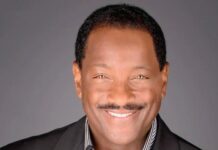
*An earlier report noted that Activist and former Gubernatorial candidate Stacey Abrams is set to re-release the first three romance novels she penned under an assumed name.
Before she ran for governor of Georgia and became a voting rights activist, Abrams wrote romance novels under a pseudonym because she thought her own name was “boring,” as reported by The Daily Beast.
Per The Atlanta Journal-Constitution, over the past 21 years, Abrams has published eight romance novels under the nom de plume, Selena Montgomery. Her first three romantic suspense novels — Rules of Engagement, The Art of Desire and Power of Persuasion, a trilogy — originally printed about 20 years ago, will be reissued in 2022 by the publisher Berkley, an imprint of Penguin Random House, per LA Focus News.
“As my first novels, they remain incredibly special to me,” said Abrams in a statement. “The characters and their adventures are what I’d wished to read as a young Black woman — stories that showcase women of color as nuanced, determined, and exciting.”
The novels all feature Black lead characters and the espionage storyline connects all three books.
Speaking about her career to ajc.com, Abram said “I write because I need to write.”
Check out additional excerpts from the conversation below.
READ MORE: Three of Stacey Abrams’ Romance Novels Set to be Reissued
My new book, While Justice Sleeps, is out today. ????
The tensions of politics and power are the core of this story — I wrote this novel to unravel a political mystery and explore what it means to have authority but no real power.
Order your copy today: https://t.co/UdAbh5nrRu pic.twitter.com/fTfSkEYS0t
— Stacey Abrams (@staceyabrams) May 11, 2021
Q: You’re not the type of writer then, who, plot-wise, can’t see beyond what’s in the beam of their headlights, just discovering the path as they go along?
A: I’ve got MapQuest. I printed it out. I know the turns.
Q: So, when you map a book out, do you use a white board? Spreadsheets?
A: I will start with a spreadsheet. For fiction, I translate it to notecards: Create the problem; complicate the problem; solve the problem. But the solution to the problem has to create a new problem. And for nonfiction, I use giant Post-it notes because that’s more about having a theme. Understanding “What’s the problem? Why is the problem? How do I solve it?” But that doesn’t require the kind of connection that fiction does.
Q: You and bestselling novelist Tayari Jones were taught by acclaimed Atlanta novelist and playwright Pearl Cleage at Spelman College. What was Cleage’s influence on your writing?
A: I took a playwriting class from Pearl Cleage and there were two things that I really internalized. One was the propulsive nature of storytelling. The audience was relying on you to move the story along, and you were required to create action in each moment. And the other was, she said, “Someone has to live, and someone has to die.” For me, that was so gripping, because it became not just a question of a character, but as she talked about it, it’s an idea. When you’re willing to fight and you’re creating tension and conflict, it is a cop-out to simply dissipate the argument. If it was important enough to fight about, then someone has to win, and someone has to die. It could be a physical death, an emotional death, but something has to give.
Q: Hacking, Supreme Court deliberations, the workings of the human genome, you seem well versed in all of it. How much time is spent on research?
A: I’ve done this for every book I write: I immerse myself in the research. My mom not only was a college librarian, she was a research librarian. In our family, if you were told go look it up, it was, go look it up. And if you had to go to the college with my mom to look it up in books, you will look it up. So, I love the research part of things, but what I like about my brain is I don’t get caught with analysis paralysis. Because of the authenticity of a story, especially when you’re doing suspense or thrillers, you have to have enough legitimacy to the story that an expert might raise an eyebrow but won’t completely dismiss it right away.
When I have specific questions, my family is my own personal Google. I can call my sister, the scientist, or my sister, the anthropologist, or my sister, the judge, or my brother’s a social worker, or my brother, who reads all these thrillers. They all have great imaginations, but they’re critical. They’ll tell me, “No, this doesn’t make sense,” or, “Yes, that can happen, but not the way you did it.”
Q: There are leading characters of different races and ethnicities in the book, but there’s a moment where three Black characters try to unlock a deeply coded clue, and it was striking because we don’t often see the genius of Black characters in thrillers. Did you read other Black thriller/mystery writers like Walter Mosley, Eleanor Taylor Bland, Barbara Neely along the way who featured strong, smart Black sleuths?
A: I read Walter much later in life. And I love his storytelling style. But for me, it was much more, “This is a story I want to tell.” I want people to see themselves in these stories. And while race is very clear, it is not the story. Often, there’s this presumption that when a character is a person of color, when a character is Black, that the story is all about their blackness. How decisions are made, and how lives are lived, and who we become is absolutely grounded in race. But it cannot be the only identifier for who we become.
Read the rest of the Q&A here.
We Publish News 24/7. Don’t Miss A Story. Click HERE to SUBSCRIBE to Our Newsletter Now!





